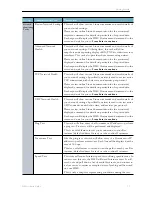
Configure a DME Stream
DME Admin Guide
47
password for the DME to receive the stream if authentication is enabled. You can get
this information from the administrator who configured the DME. By default, the
username and password are broadcast/broadcast.
4. Enable the stream to be sent to the DME.
When sending a stream from another DME:
1. In the DME, launch the management interface, log in, and go to
System Configuration
>
Flash Push Settings
. Find an open slot from the 25 possible slots, enter the server IP
address or DNS host name, and enter the port (1935 is the default port for RTMP). The
port number is required. You also need an entry for Application name for the
destination. If the destination is another DME, most likely the name would be live. Enter
the destination publishing point name. In the stream name field, enter the name of the
stream that exists on the local DME that you want to push out. The
Target Name
is
optional and is the synonymous with the publishing point name. The other fields like
Emulate
,
swfURL
, and
pageURL
are optional and are only needed if the destination server
requires special value to be inserted for them. They are not required for a destination
DME. The DME push component currently emulates a FMLE v3.0. If a different
emulation string is required, enter it here. This is not required for a destination DME. If
security is enabled on the destination server you will need the user name and password so
enter the appropriate values here.
2. This stream can now be redistributed by the DME.
I n - 2 < R T P Au t o Un ic a s t
From a source perspective, these two mechanisms are very similar. The only major difference
is whether the stream is sent to the RTP Server or the Multi-protocol server. This is
determined by DME port that the stream is sent to. In general, In-2 is preferred to In-3. The
only situation where In-3 should be used is if the UDP protocol is required. since IN-2 does
not support UDP. Note that depending on the mechanism used, and the output protocols
required, manual configuration of In-6 or Out-10 is needed so the stream can pass between
the two servers.
This use case is commonly used to publish streams to the DME from VB7000 encoders
running v3.0 or earlier software. These early versions of the Vbrick appliance did not support
RTMP, hence the preferred mechanism of RTMP Push (IN-1) is not available. In this
scenario the input is sourced from an Auto Unicast transmitter on a Vbrick 7000/9000 Series
(H.264) encoder. Auto Unicast is a transmitter mode that allows the Vbrick encoder to
“automatically” establish and maintain a connection with a streaming server. The stream is
pushed to a configured publishing point location on the DME to which external clients can
connect to retrieve the stream. For example, you can place a Vbrick encoder inside a private
network and configure it to Auto Unicast to a DME. External clients will then connect to the
DME server via the Internet. Auto Unicast uses RTSP to control the session. It establishes a
connection with the streaming server, negotiates ports, and begins streaming to the server.
Once established, the encoder will push this stream to the DME until the session is
terminated (typically by disabling the transmitter).
In the case of both In-2 and In-3, the Auto Unicast transmitter can be configured to send a
UDP stream or a TCP stream. The key difference is that a TCP stream provides guaranteed
delivery and therefore adds additional overhead; UDP does not and lost UDP packets are not
Summary of Contents for dme
Page 1: ...Vbrick Distributed Media Engine vbrick dme v3 21 0 Admin Guide March 2019 ...
Page 12: ...xii Preface ...
Page 20: ...8 Vbrick Systems Inc ...
Page 22: ...10 Vbrick Systems Inc ...
Page 54: ...42 Vbrick Systems Inc ...
Page 156: ...144 Vbrick Systems Inc ...
Page 160: ...148 Vbrick Systems Inc ...
Page 176: ...164 Vbrick Systems Inc ...
Page 180: ...168 Vbrick Systems Inc ...
Page 194: ...182 Vbrick Systems Inc ...
Page 202: ...190 Vbrick Systems Inc http dme_ip_address HDS masterplaylistname manifest f4m ...
Page 208: ...196 Vbrick Systems Inc ...
















































